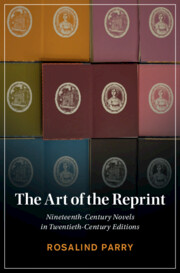Book contents
- The Art of the Reprint
- Cambridge Studies in Nineteenth-Century Literature and Culture
- The Art of the Reprint
- Copyright page
- Dedication
- Contents
- Figures
- Acknowledgments
- Introduction
- Chapter 1 Clare Leighton & Thomas Hardy’s The Return of the Native
- Chapter 2 Rockwell Kent & Herman Melville’s Moby Dick
- Chapter 3 Fritz Eichenberg & Charlotte Brontë’s Jane Eyre
- Chapter 4 Joan Hassall & The Complete Novels of Jane Austen
- Coda
- Notes
- Bibliography
- Index
- Cambridge Studies in Nineteenth-Century Literature and Culture
Chapter 2 - Rockwell Kent & Herman Melville’s Moby Dick
Published online by Cambridge University Press: 23 March 2023
- The Art of the Reprint
- Cambridge Studies in Nineteenth-Century Literature and Culture
- The Art of the Reprint
- Copyright page
- Dedication
- Contents
- Figures
- Acknowledgments
- Introduction
- Chapter 1 Clare Leighton & Thomas Hardy’s The Return of the Native
- Chapter 2 Rockwell Kent & Herman Melville’s Moby Dick
- Chapter 3 Fritz Eichenberg & Charlotte Brontë’s Jane Eyre
- Chapter 4 Joan Hassall & The Complete Novels of Jane Austen
- Coda
- Notes
- Bibliography
- Index
- Cambridge Studies in Nineteenth-Century Literature and Culture
Summary
Herman Melville’s most famous illustrator, Rockwell Kent (1882–1971) designed and illustrated Moby Dick in 1930. At the same time, he was writing and illustrating his own book, N by E, an account of his recent misadventures on the crew of a small boat sailing to Greenland. In both projects, Kent depicted ship, ocean, sailor, and creature with obsessive accuracy. Such a devoted socialist that he donated a trove of paintings to the Soviet Union in 1960 even after revelations about the regime that disillusioned many lifelong socialists, he was also a keen observer of the coastlines of Maine, Newfoundland, Alaska, and the Arctic. The specificity of his knowledge and the fervor with which he sought out adventures show in his inky, fantastic tableaus and head- and tailpieces for Moby Dick. His edition coincided with and helped solidify Melville’s canonization in the twentieth century – the so-called Melville revival – while also reaching a new kind of reader through the Book-of-the-Month Club. His was perhaps the most beloved American illustrated reprint of its time, and certainly the best known of the reprints examined here.
Keywords
- Type
- Chapter
- Information
- The Art of the ReprintNineteenth-Century Novels in Twentieth-Century Editions, pp. 56 - 93Publisher: Cambridge University PressPrint publication year: 2023

